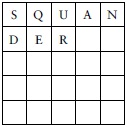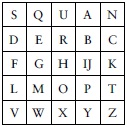Have His Carcase (48 page)
Authors: Dorothy L. Sayers

correspondent might very wel hit on some word that Alexis had marked in
advance. It might be anything.’
‘Perfectly true. Then the only bit of help we get from this is that the cipher
used was an English word, and that the letters were probably written in English.
That doesn’t absolutely folow, because they might be in French or German or
Italian, al of which have the same alphabet as English; but they can’t be in
Russian at any rate, which has an alphabet totaly different. So that’s one
mercy.’
‘If it’s anything to do with Bolsheviks,’ said Glaisher, thoughtfuly, ‘it’s a bit
surprising they didn’t write in Russian. It would have made it doubly safe if they
had. Russian by itself would be bad enough, but a Russian cipher would be a
snorter.’
‘Quite. As I’ve said before, I can’t quite swalow the Bolshevik theory. And
yet – dash it al! I simply can
not
fit these letters in with the Weldon side of the
business.’
‘What
I
want to know,’ put in the Inspector, ‘is this. How did the murderers,
whoever they were, get Alexis out to the Flat-Iron? Or if it was Bolsheviks that
got him there, how did Weldon & Co. know he was going to be there? It must
be the same party that made the appointment and did the throat-cutting. Which
brings us to the point that either Weldon’s party wrote the letter or the foreign
party did the murder.’
‘True, O king.’
‘And where,’ asked Harriet, ‘does Olga Kohn come in?’
‘Ah!’ said Wimsey, ‘there you are. That’s the deepest mystery of the lot. I’l
swear that girl was teling the truth, and I’l swear that the extremely un-Irish Mr
Sulivan was teling the truth too. Little flower in the crannied wal I pluck you
out of the crannies, but, as the poet goes on to say,
if
I could understand I
should know who the guilty man is. But I don’t understand. Who is the
mysterious bearded gentleman who asked Mr Sulivan for the portrait of a
Russian-looking girl, and how did the portrait get into the corpse’s pocket-
book, signed with the name Feodora? These are deep waters, Watson.’
‘I’m coming back to my original opinion,’ grumbled the inspector. ‘I believe
the felow was dotty and cut his own throat and there’s an end of it. He
probably had a mania for colecting girls’ photographs and sending himself
letters in cipher.’
‘And posting them in Czechoslovakia?’
‘Oh, wel, somebody must have done that for him. As far as I can see, we’ve
no case against Weldon and no case against Bright, and the case against
Perkins is as ful of holes as a colander. As for Bolsheviks – where are they?
Your friend Chief-Inspector Parker has put out inquiries about Bolshevik
agents in this country, and the answer is that none of ’em are known to have
been about here lately, and as regards Thursday, 18th, they al seem to be
accounted for. You may say it’s an unknown Bolshevik agent, but there aren’t
as many of those going about as you might think. These London chaps know
quite a lot more than the ordinary public realises. If there’d been anything funny
about Alexis and his crowd, they’d have been on to it like a shot.’
Wimsey sighed, and rose.
‘I’m going home to bed,’ he declared. ‘We must wait til we get the
photographs of the paper. Life is dust and ashes. I can’t prove my theories and
Bunter has deserted me again. He disappeared from Wilvercombe on the same
day as Wiliam Bright, leaving me a message to say that one of my favourite
socks had been lost in the wash and that he had lodged a complaint with the
management. Miss Vane, Harriet, if I may cal you so, wil you marry me and
look after my socks, and, incidentaly be the only woman-novelist who ever
accepted a proposal of marriage in the presence of a superintendent and
inspector of Police?’
‘Not even for the sake of the headlines.’
‘I thought not. Even publicity isn’t what it was. See here, Superintendent, wil
you take a bet that Alexis didn’t commit suicide and that he wasn’t murdered
by Bolsheviks?’
The Superintendent replied cautiously that he wasn’t a sporting man.
‘Crushed again!’ moaned his lordship. ‘Al the same,’ he added, with a flash
of his old spirit, ‘I’l break that alibi if I die for it.’
XXVI
THE EVIDENCE OF THE BAY MARE
‘Hail, shrine of blood!’
The Bride’s Tragedy
Wednesday, 1 July
The photographs of the paper found on the corpse duly arrived next morning,
together with the original; and Wimsey, comparing them together in the
presence of Glaisher and Umpelty, had to confess that the experts had made a
good job of it. Even the original paper was far more legible than it had been
before. The chemicals that remove bloodstains and the stains of dyed leather,
and the chemicals that restore the lost colour to washed-out ink had done their
work wel, and the colour-screens that so ingeniously aid the lens to record one
colour and cut out the next had produced from the original, thus modified, a
result in which only a few letters here and there were irretrievably lost. But to
read is one thing; to decipher, another. They gazed sadly at the inextricable
jumble of letters.
XNATNX
RBEXMG
PRBFX ALI MKMG BFFY, MGTSQ JMRRY. ZBZE FLOX P.M. MSIU
FKX FLDYPG FKAP RPD KL DONA FMKPC FM NOR ANXP.
SOLFA TGMZ DXL LKKZM VXI BWHNZ MBFFY MG, TSQ A
NVPD NMM VFYQ. CJU ROGA K.C. RAC RRMTN S.B. IF H.P. HNZ
ME? SSPXLZ DFAX LRAEL TLMK XATL RPX BM AEBF HS
MPIKATL TO HOKCCI HNRY. TYM VDSM SUSSX GAMKR, BG AIL
AXH NZMLF HVUL KNN RAGY QWMCK, MNQS TOIL AXFA AN
IHMZS RPT HO KFLTIM. IF MTGNLU H.M. CLM KLZM AHPE ALF
AKMSM, ZULPR FHQ – CMZT SXS RSMKRS GNKS FVMP RACY
OSS QESBH NAE UZCK CON MGBNRY RMAL RSH NZM, BKTQAP
OSS QESBH NAE UZCK CON MGBNRY RMAL RSH NZM, BKTQAP
MSH NZM TO ILG MELMS NAGMJU KC KC.
TQKFX BQZ NMEZLI BM ZLFA AYZ MARS UP QOS KMXBJ SUE
UMIL PRKBG MSK QD.
NAP DZMTB N.B. OBE XMG SREFZ DBS AM IMHY GAKY R.
MULBY M.S. SZLKO GKG LKL GAW XNTED BHMB XZD NRKZH
PSMSKMN A.M. MHIZP DK MIM, XNKSAK C KOK MNRL CFL
INXF HDA GAIQ.
GATLM Z DLFA A QPHND MV AK MV MAG C.P.R. XNATNX PD
GUN MBKL I OLKA GLDAGA KQB FTQO SKMX GPDH NW LX
SULMY ILLE MKH BEALF MRSK UFHA AKTS.
At the end of a strenous hour or two, the folowing facts were established:
1. The letter was written on a thin but tough paper which bore no
resemblance to any paper found among the effects of Paul Alexis. The
probability was thus increased that it was a letter received, and not written by
him.
2. It was written by hand in a purplish ink, which, again, was not like that
used by Alexis. The additional inference was drawn that the writer either
possessed no typewriter or was afraid that his typewriter might be traced.
3. It was not written in wheel-cipher, or in any cipher which involved the
regular substitution of one letter of the alphabet for another.
‘At any rate,’ said Wimsey, cheerfuly, ‘we have plenty of material to work
on. This isn’t one of those brief, snappy “Put goods on sundial” messages which
leave you wondering whether E realy is or is not the most frequently-recurring
letter in the English language. If you ask me, it’s either one of those devilish
codes founded on a book – in which case it must be one of the books in the
dead man’s possession, and we only have to go through them – or it’s a
different kind of code altogether – the kind I was thinking about last night, when
we saw those marked words in the dictionary.’
‘What kind’s that, my lord?’
‘It’s good code,’ said Wimsey, ‘and pretty baffling if you don’t know the

key-word. It was used during the War. I used it myself, as a matter of fact,
during a brief interval of detecting under a German alias. But it isn’t the
exclusive property of the War Office. In fact, I met it not so long ago in a
detective story. It’s just –’
He paused, and the policemen waited expectantly.
‘I was going to say, it’s just the thing an amateur English plotter might readily
get hold of and cotton on to. It’s not obvious, but it’s accessible and very
simple to work. It’s the kind of thing that young Alexis could easily learn to
encode and decode; it doesn’t want a lot of bulky apparatus; and it uses
practicaly the same number of letters as the original message, so that it’s highly
suitable for long epistles of this kind.’
‘How’s it worked?’ asked Glaisher.
‘Very prettily. You choose a key-word of six letters or more, none of which
recurs. Such as, for example, SQUANDER, which was on Alexis’ list. Then
you make a diagram of five squares each way and write the key-word in the
squares like this:
‘Then you fil up the remaining spaces with the rest of the alphabet in order,
leaving out the ones you’ve already got.’
‘You can’t put twenty-six letters into twenty-five spaces,’ objected Glaisher.
‘No; so you pretend you’re an ancient Roman or a medieval monk and treat
I and J as one letter. So you get this.’

‘Now, let’s take a message – What shal me say? “Al is known, fly at once”
– that classic hardy perennial. We write it down al of a piece and break it into
groups of two letters, reading from left to right. It won’t do to have two of the
same letters coming together, so where that happens we shove in Q or Z or
something which won’t confuse the reader. So now our message runs AL QL
IS KN OW NF LY AT ON CE.’
‘Suppose there was an odd letter at the end?’
‘Wel, then we’d add on another Q or Z or something to square it up. Now,
we take our first group, AL. We see that they come at the corners of a
rectangle in which the other corners are SP. So we put down SP for the first
two letters of the coded message. In the same way QL becomes SM and IS
becomes FA.’
‘Ah!’ cried Glaisher, ‘but here’s KN. They both come on the same vertical
line. What happens then?’
‘You take the letter next below each – TC. Next comes OW, which you can
do for yourself by taking the corners of the square.’
‘MX?’
‘MX it is. Go on.’
‘SK,’ said Glaisher, happily taking diagonals from corner to corner, ‘PV,
NP, UT –’
‘No, TU. If your first diagonal went from bottom to top, you must take it the
same way again. ON = TU, NO would be UT.’
‘Of course, of course. TU. Hulo!’
‘What’s the matter?’
‘CE come on the same horizontal line.’
‘In that case you take the next letter to the
right
of each.’
‘But there isn’t a letter to the right of C.’
‘Then start again at the begininning of the line.’
This confused the Superintendent for a moment, but he finaly produced DR.
‘That’s right. So your coded message stands now: SP SM FA TC MX SK
PV NP TU DR. To make it look prettier and not give the method away, you
can break it up into any lengths you like. For instance. SPSM FAT CMXS
KPV NPTUDR. Or you can embelish it with punctuation at hapazard. S.P.
